Thimbles, those small but remarkable tools used to protect fingers during sewing, have a history that dates back to ancient times. These tiny wonders have witnessed incredible advancements and cultural significance throughout the years.
Ancient Origins: Unearthing the First Thimbles
Believe it or not, the earliest known thimbles were discovered in Pompeii, dating back to the 1st century AD. Made of bronze, these thimbles marked the humble beginnings of a practical tool that would endure the test of time.♯
Evolution in Materials and Designs
As centuries passed, thimbles evolved in both materials and designs. During medieval times, craftsmen experimented with various materials such as leather, wood, and metal. It was in the 14th century that Nuremberg, Germany, gained recognition as a major hub for producing brass thimbles.
The 17th century brought further innovation, with the rise of silver and gold thimbles among the wealthy. These luxurious thimbles not only served practical purposes but also became symbols of status and prestige.
Thimbles Beyond Sewing: Versatility in Trades and Cultures
Thimbles did not limit themselves to the world of sewing alone. They found their way into various crafts such as bookbinding, leatherworking, and lace-making. These versatile tools offered protection and precision across different trades.
But thimbles didn’t stop there. They also made their way into popular culture and folklore. In the beloved story of “Peter Pan,” a thimble was used symbolically as a kiss. Even the classic board game Monopoly featured a thimble as one of its original game pieces, reflecting its common presence in early 20th-century homes.♯
Continued on next page 👇(page 2)👇
